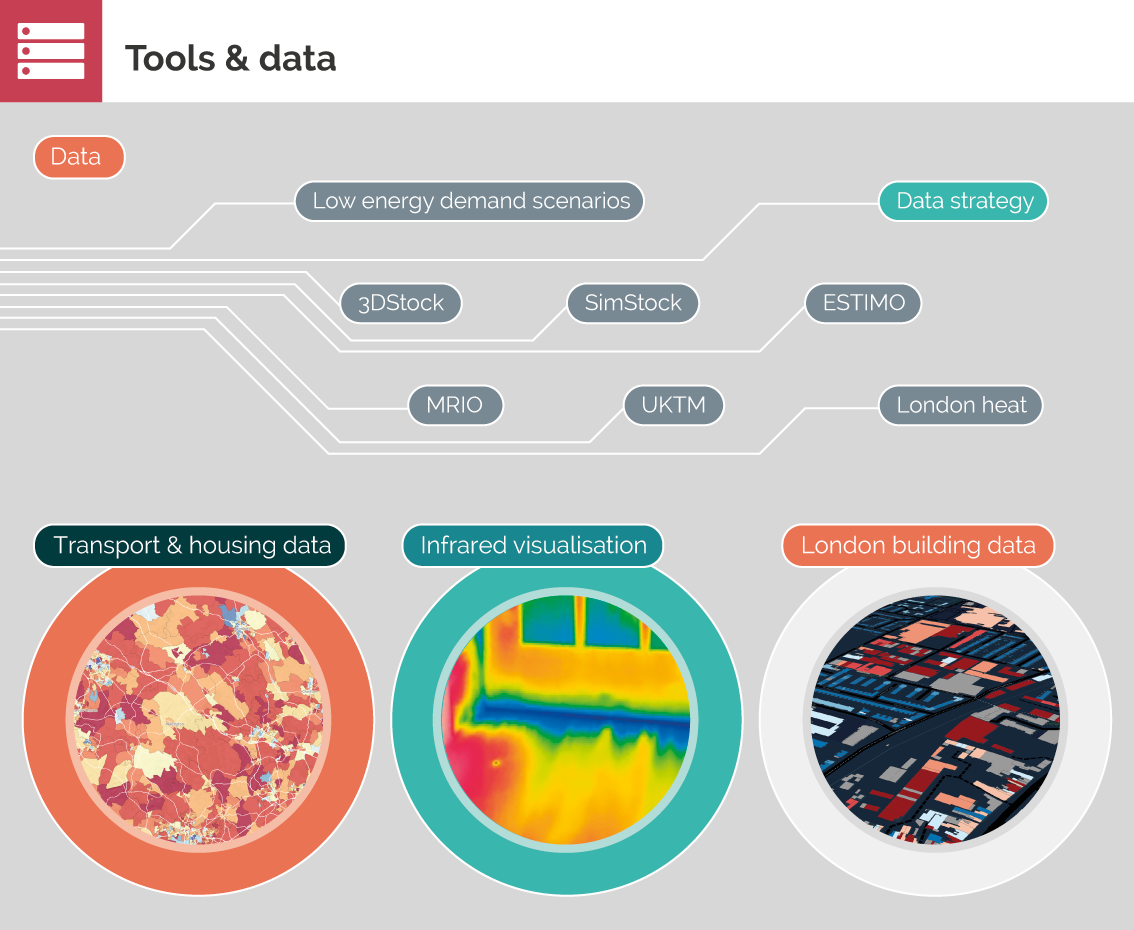
Decision-makers require analytical tools to formulate effective policies, and good quality data to understand and track changes in energy use. CREDS work has contributed to a number of tools and to understanding data needs.
We have developed a unique approach to modelling future energy demand, using linked sectoral models and an energy system model [1], see also The potential for reducing demand.
We have developed a Place Based Carbon Calculator for England combining spatially disaggregated transport and housing data [2] and launched it as a freely available tool, in particular for local authorities.
We have developed techniques for predicting spatially disaggregated car ownership, showing that neighbourhoods with high predicted car ownership will have higher energy use per capita and those with relatively high electric vehicle uptake will have lower energy use [3].
We have continued to use and develop the UK Transport Energy Air Pollution Model UK-TEAM [4], in particular to address questions at higher levels of spatial disaggregation and to soft-link to energy systems models [5].
Our research shows that the correlation between EPCs and energy use is weak, both in homes [6, 7] and in non-residential buildings. Better energy ratings for buildings are needed [8]. EPC accuracy and usefulness could be considerably enhanced using measured energy data to obtain in-use heat transfer coefficients through the Smart Meter Enhanced Thermal Energy Rating (SMETER) programme [9].
With the 3DStock and SimStock models [10] it will be possible for the first time to provide a geo-located, 3 dimensional representations of every building. This includes mixed use (residential and non-residential) buildings, which have historically not been well-understood.
We have developed a novel high-resolution methodology for assessment of the impact of electrification of heat and transport impact on transformer headroom, using socio-economic indicators to inform the likely penetration of different low carbon technologies and linking to relevant spatial datasets [11].
We have also developed a model which simulates anthropogenic heat emissions across London. This has the potential to overcome limitations in temporal disaggregation of energy demand [12].
We have further developed our Multi-Regional Input Output modelling [13], which enables analysis of resource efficiency [14] and provides key insights to a range of government departments and the Climate Change Committee.
CREDS research has also progressed work on UK energy systems models, UKTM and ESTIMO, in particular to understand pathways to heat decarbonisation, by adding new vectors and developing the concept of evolvability. The models have contrasting strengths: ESTIMO has sufficient temporal granularity to model system operability reliably [15], whereas UKTM models long-run technology evolution [16] and can be used to integrate energy service rich sectoral models [17].
We have developed an original method for analysing energy and transport poverty in the UK, using data on heating needs, energy efficiency, access to services and social vulnerability.
Data availability remains a challenge. Data infrastructure (monitoring, reporting and transparent processes) is the foundation of any policy design for net-zero, and is not sufficiently in place. There is a lack of harmonised data on energy and transport use across the four countries of the UK. The absence of accessible high-quality data is a significant barrier to assessments of mitigation potential in many sectors. Data on energy use in industry is particularly inadequate and we have developed a data strategy to improve this [18].
Infra-red visualisation is now practical and cost effective on-site during construction to identify building defects. Modern heating technologies can provide a range of data to help improve heating system performance. Along with analysis and visualisation of data from monitored buildings during construction and in occupation, these can help reduce the performance gap, and therefore assist UK buildings transition to net-zero. Much of the data is already being collected or can now be collected at minimal cost [19].
Evidence
- Energy demand reduction options for meeting national zero-emission targets in the United Kingdom | Research paper, 2022
- Why we built a Place-Based Carbon Calculator | CREDS Blog, 2022
- Spatially disaggregated car ownership prediction using deep neural networks | Research paper, 2021
- Lifestyle, efficiency and limits: modelling transport energy and emissions using a socio-technical approach | Research paper, 2022
- The role of energy demand reduction in achieving net-zero in the UK: Transport and mobility | CREDS Report, 2021
- What do empirical findings reveal about modelled energy demand and energy ratings? Comparisons of gas consumption across the English residential sector | Research paper, 2019
- Quantifying the measurement error on England and Wales EPC ratings | Research paper, 2019
- The over-prediction of primary energy use intensity by EPCs in Great Britain: A direct comparison of EPC-modelled and smart metered energy use in gas-heated | Research paper, 2023
- Creating domestic building thermal performance ratings using smart meter data | Research paper, 2020
- Building stock energy modelling in the UK: the 3DStock method and the London Building Stock Model | Research paper, 2020
- A high-resolution geospatial and socio-technical methodology for assessing the impact of electrified heat and transport on distribution network infrastructure | Research paper, 2023
- Dynamic Anthropogenic activitieS impacting Heat emissions (DASH v1.0): development and evaluation | Research paper, 2020
- Thermodynamic efficiency gains and their role as a key ‘engine of economic growth’ | Research paper, 2021
- Untangling the drivers of energy reduction in the UK productive sectors: Efficiency or offshoring? | Research paper, 2018
- Meeting UK heat demands in zero emission renewable energy systems using storage and interconnectors | Research paper, 2021
- Heat decarbonisation modelling approaches in the UK: An energy system architecture perspective | Research paper, 2020
- The role of energy demand reduction in achieving net-zero in the UK | CREDS report, 2021
- A data strategy to promote the clean growth of UK industries | CREDS Report, 2020
- A structured open data collection on occupant behaviour in buildings | Research paper, 2019
Banner photo credit: Pat Whelen on Unsplash
